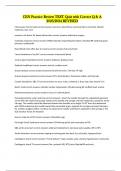CEN Practice Review TEST Quiz with Correct Q & A
2023/2024 REVISED
Interosseus sites for peds correct answers sternum, distal femur, proximal tibia ( common), Medial
malleolus, iliac crest
common risk factor for bowel obstruction correct answers abdominal surgery
Cushing's response correct answers TRIAD:indicates impending herniation. Elevated BP, widening pulse
pressure, bradycardia
Head bleed most often due to trauma correct answers Sub-arachnoid
"worst headache of my life" correct answers intracranial bleed
venous type head bleed correct answers Subdural: gradual onset
Epidural headbleed correct answers arterial, sudden onset
Graves disease correct answers Excessive throid hormone: TSH low, T4 high
Graves disease treatment correct answers PTU, beta blockers, Potassium iodide, anti-thyroids
CLuster headaches: S&S, TX correct answers no aura, male, unilateral, 1-8 per day, lasts around 1 hr.
Beck's triad correct answers indicates cardiac tamponade: JVD,decreasing BP, muffled heart sounds
Pheochromocytoma correct answers tum,or in adrenal gland
Pericardiocentesis: when and how correct answers ◦Insert the needle through the subxiphoid approach
on the left side under fluoroscopy. Advance the needle and syringe until the needle tip is posterior to the
rib cage. The needle should be advanced toward the shoulder at an angle 15-20° from the abdominal
wall. While advancing the needle toward the pericardial space, aspirate the syringe and inject lidocaine
for a better analgesic effect. Continue to advance the needle until fluid is aspirated in the syringe or the
ECG monitor shows ST elevation
How to make Dx of PID correct answers CHandalier sign
Fitz-Hugh-Curtis Syndrome correct answers COntinuing pelvic pain secondary to PID
S&S aortic aneurysm correct answers widened mediastinum, decrease pulse quality, diff. in BP's
Aortic dissection correct answers ripping or tearing pain into back, loss of pulses, hypoperfusion
Cardiogenic shock correct answers "Pump failiure" lungs crackles, pale, clammy, hypotension, tachcardia
Cardiogenic shock TX correct answers Dec. preload: MS, NTG,Lasix, NiprideRSI and vent.,
, Drugs that decrease pre-load correct answers Morphine, lasix, nipride, NTG
Drugs that decrease afterload correct answers Vasodilators, nipride, Ace inhibitors, High dose NTG,
Hydralazione
Drugs that increse afterload correct answers Vasoconstrictors, Norepi, Epi
Drugs that increase contractility correct answers Inotrope, Dopamine, Dobutamine, Inocor
PEA causes: H's correct answers Hypothermia, hypovolemia, hyperkalemia,hypoxia,hydrogen ion acidosis
PEA Causes T's correct answers Toxins, Tamponade,Tension pneumo, Thrombus(coronary), thrombus (
pulmonary), Trauma
Kernig's sign correct answers Meningitis test: flex the knee and head comes up
Brudzinski's sign correct answers Meningitis test: flex the neck and legs go up
Hyperkalemia correct answers Above 5.5, cardiac effects, asystole, tx: d50, peaked T waves
Hypokalemia correct answers Less than 3.5, causes v&d, EKG:sagging s-t, T wave depression, PACs, PVCs,
Blocks
Hyponatremia correct answers tacycardia, flat neck veins, seizures, dizziness,
Hypernatremia correct answers fluidloss, taking too much Na, Na > 145, brain cells shrink, Hypo-osmolar
solution
Neurogenic shock correct answers Skin WARM below level of injury, HR normal
Drugs offered to sexual assault victim correct answers STD prophylaxis
Ludwig's angina correct answers SUbmandibular infection
Tricyclic overdose correct answers sinus tach (early), PVCs, SVT,VT,widening QRS 3Cs: cardiac,
convulsions, Coma),
Tricyclic OD tx: correct answers no beta blockers, Na Bicarb
Hypocalcemia correct answers diet, parathyroid glands, transfusions. < 5 mg. QT prolonged, T wave
inverted,
Chvostek's signs correct answers hypocalcemia, contrction of facial muscles when tapped
Trousseou's sign correct answers Hypocalcemia: carpal spasms
Barrett's esophagus correct answers cancer f rom GERD




